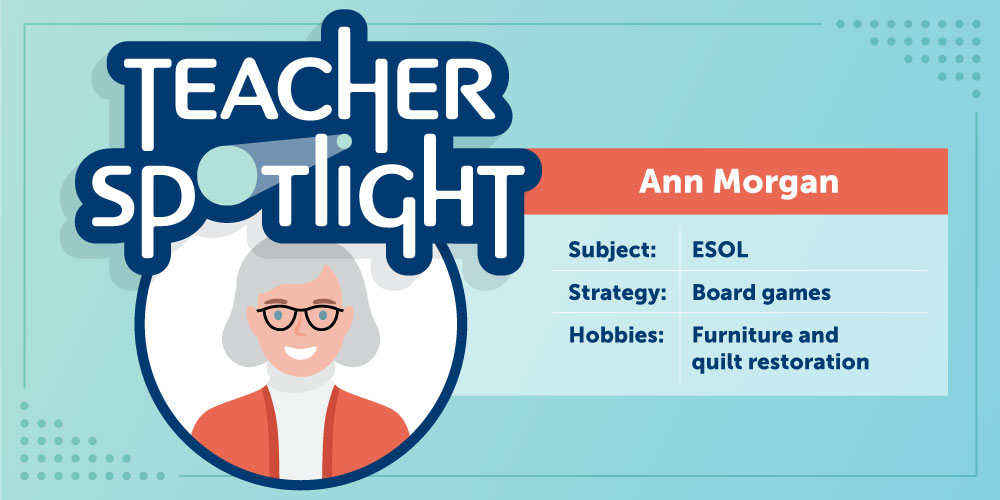It’s almost impossible to describe Ann Morgan without pulling a number of descriptors from the adjective barrel.
She is an ELL teacher and author. She’s smart. She’s funny. She’s a bit sarcastic, too. She’s resourceful, thorough, amiable, driven, and eloquent. In short, when you meet Ann Morgan, you know she’s a darn good educator from whom all of us can learn valuable pedagogical insight.
Not sure how one person can earn so many superlative merit badges? Read our latest Teacher Spotlight interview.
As our country grows richer with diversity, there’s a heightened need for ELL teachers. You’ve worked in this arena for a while, and at this point, people consider you an authority. What led you to teaching English as a second language in the first place?
I started my career at an international school in England, and the kids LOVED their English language teacher, so my introduction to the specialty was very positive. When I got back to the states, I spent years in the Title 1 schools of a huge metropolitan system with many, many, many ELLs.
It was rewarding and easy to see how much their and our investments in learning paid off academically, personally, and culturally.
Over time, I had kids from every continent except Antarctica, speaking languages from every iteration of Spanish to obscure dialects. The kids and their families were eager, happy, and often confused about school. It was rewarding and easy to see how much their and our investments in learning paid off academically, personally, and culturally.
I moved into semi-administrator, county trainer, and other non-classroom roles that I had prepared for with my first Master’s degree, without preparing for how much I missed working directly with kids. By then, I had my own personal kids who needed me at home when they got off the bus.
In my school system, ESOL (English for Speakers of Other Languages) teachers were among the few who had part-time work hours available, so I went back for a TESOL Master’s and pared back my hours. I got home 3 seconds before my middle-schooler, but we were both relieved.
Becoming an ESOL specialist worked for me professionally as well as personally, and remains one of the best decisions I’ve ever made.
What are some challenges that you feel are unique to ELL teachers? Any tips on how to muscle through those obstacles?
Where to begin…we and our students are easily misinterpreted. ELL teachers are not raging polyglots, although many are bilingual. When asked what languages I speak, my answer is “English.” We can’t translate or interpret on demand.
One teacher sent a note to my room after a student arrived from Sri Lanka, asking me to send her all my 4th grade materials in Tamil. There are 400 + non-English languages in the US, but English is the target.
Most people don’t know what we do with ELLs and what they’re going through trying to learn content and language and culture all at once. Their family backgrounds, even for the kids born in the USA (half of all ELLs are US-born) run the gamut from refugees to political asylees to high-end professional families on temporary assignment in the US.
Just hearing an ELL chatting in English at lunch doesn’t mean they’ve learned English. There’s a big gap between language for hanging out and language for learning, and it can take up to 10 years to master all the necessary academic language in listening, speaking, reading, and writing.
We and other teachers can’t assume anything about this population’s proficiencies in their first languages, their families and living conditions, their past schooling, whatever trauma they’ve been exposed to, and anything else that we can so easily find out or infer about native English-speaking students.
It can be hard to convince some staff that language growth is staggered and inconsistent. Just hearing an ELL chatting in English at lunch doesn’t mean they’ve learned English. There’s a big gap between language for hanging out and language for learning, and it can take up to 10 years to master all the necessary academic language in listening, speaking, reading, and writing.
If we ESOL specialists muscle through obstacles, they’re obstacles that our students face, and for whom we have to consistently advocate. Federal and state laws are not in their favor; ELLs are generally expected to be able to take and succeed at high-stakes testing after one calendar year from their arrival in this country.
How would you do if I dumped you in Polynesia and gave you one year to function as well as the indigenous learners? The stress this puts on kids is more than shared by the classroom or content teachers who have to get everybody on grade level at warp speed.
ESOL teachers tend to work with the same kids and teachers over several years, so it behooves us to be team players, and help keep expectations realistic for adjustment behaviors as well as learning. We also work to keep ELLs out of special education classes unless it’s a true need. As one of my colleagues said, “These rules are being made by fools who haven’t even been on a street where there’s a school since they graduated.”
Teaching English Language Learners is your latest book. You wrote it for elementary teachers with ELLs in their classrooms, but who don’t have ELL training. Tell us a little about what readers can expect.
They can expect an easy read. No jargon, clearly defined chapters, and bulleted take-aways so it’s an easy reference. Like this:
- A lot of anecdotes and photos
- Lesson format ideas and PBL activities
- How to teach writing
- Behavioral and cultural notes
- How to discern learning difficulties from lack of English; how to figure out what other kind of help kids may need and how to get it for them.
- What to expect and/or accept at different language proficiency levels
- How to get to know your ELLs so they and their families trust you
Related: Teaching English Language Learners: A Handbook for Elementary Teachers(Open Link in new tab)
You’ve done it all: elementary classroom work, teacher training, and as we just chatted about, you’re also an author. You’ve also worked as a curriculum writer—can you tell our audience what goes into creating learning material?
I work backwards.
For ELLs, I look at the next unit or theme. Then I figure out what the basic learning HAS to be to help the kids move ahead. I figure out the content language and grammar skills, then plan how to teach/practice it with visuals and hands-on activities. By doing it ahead of time, ELLs can go into the classroom learning stream with floaties. The idea isn’t to teach content, but to teach the language that kids need to access content.
There’s language and learning in almost everything, and visuals are a major support for ELLs. Share images that relate to topic or target vocabulary.
For general writing, mostly for teacher training, it’s pretty much the same process. What should everyone know? What’s a straight-forward way to get them where they have to go? What resources can I assume that teachers and kids will or won’t have available? How can I make this engaging, multi-modal, and easily modified? (with bonus points for succinct, fun, and interactive) If I’m writing for an outlet, I have to conform to their plan and format.
Our readers love to hear about (read: steal) classroom activities. Do you have any favorites in your pedagogy arsenal?
- The camera. There’s language and learning in almost everything, and visuals are a major support for ELLs. Share images that relate to topic or target vocabulary. Older kids can do the same with set content-based parameters. You can start in the classroom or elsewhere in and around the school.
- Project Based Learning, especially for ELLs. A recent Kinder group had 7 kids from 7 countries with 7 languages – not a lot of common ground. PBL creates that common experience, builds cohesion, minimizes gaps, and begets a product. It also makes it easy to enforce the posted classroom rules of “Be Nice” and “Have Fun”, even with Middle Schoolers.
- PBL for them can have a cultural bent, like carving jack o’lanterns, making s’mores (sadly, in a microwave), writing letters to folks in different parts of the country (ask your staff) and tracking that on a map, corresponding with experts in areas the kids are studying or are personally interested in, participating in a local charity drive or collection (toys, coats, canned food).
- Read-alouds, every grade as many times a week as you can squeeze it in. It can be student choice, a genre, author, or non-fiction based on classroom work. Just read to the kids and do the voices. With some titles, watch the movie (at recess with popcorn) after the book as discussion (writing, illustrating, language of comparison and contrast, literary elements, non-fiction elements) fodder.
- Games. There’s a LOT of language in games. Chutes and Ladders for parts of speech and Cause & Effect. Twister for right-left, colors, and prepositions of place, Go Fish for asking questions, 20 Questions for adjectives, Memory for several parts of speech, Hangman for spelling and academic vocabulary. In general, procedural words plus understanding, following, and restating directions.
You’ve worked with as a course facilitator for Teaching Channel as well. In fact, you’ve helmed PD that covers topics ranging from teaching the history of immigration to leveraging graphic novels in the classroom. Tell us about what learners can expect in those courses?
Lots of primary sources (including first-person narratives) and space for personal experiences in the immigration course. The history of immigration seems pretty straight-forward and has a lot of statistics connected to it, but the course opens the lens wider to include what preceded, connected, and followed immigrant experiences.
A virtual light-bulb goes on with the academic rigor and value of graphic novels in ELA as well as in content areas.
A virtual light-bulb goes on with the academic rigor and value of graphic novels in ELA as well as in content areas. The resources and academics offered in the Graphic Novels course are often a big surprise, even to teachers who already love and appreciate the format. Both courses easily extend beyond the obvious to other areas of Humanities and the Arts.
You’re not writing, creating curriculum, or teaching. In those few minutes each day, where might we find you? (In other words, do you have any non-teacherly interests and hobbies?)
My family, especially a sweet, curious little guy who is very, very good at being 2 1/2. I love to rescue/repair/revive old quilts and furniture when I’m not reading or stupefied by crime show reruns on TV. (Although I wait in the kitchen till the grotesque opening scene ends – when the violins stop screaming, it’s safe to come out.)
I’m a black-belt thrifter for frames and fabric, usually to use on a commission for someone with old or broken family jewelry. They won’t wear Aunt Alice’s button earrings and brooches but can’t throw them away, either. So, I use the pieces to make a framed something – in whatever configuration or scene they want – that reminds them of Aunt Alice. I’m a really good gluer. When I’m not doing teacherly writing, I fun write for myself, little kids, and space nerds.
What do you love most about teaching?
The kids and my colleagues.







